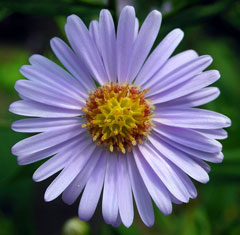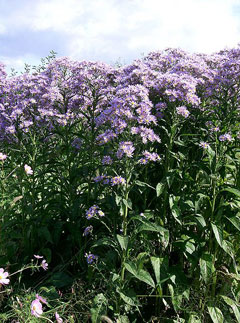 |
|
http://commons.wikimedia.org/wiki/User:Pascalou_petit |
 |
| http://commons.wikimedia.org/wiki/User:KENPEI |
Translate this page:
Summary
Physical Characteristics

 Aster tataricus is a PERENNIAL growing to 2 m (6ft) by 1.2 m (4ft in).
Aster tataricus is a PERENNIAL growing to 2 m (6ft) by 1.2 m (4ft in).
See above for USDA hardiness. It is hardy to UK zone 3. It is in flower from September to October. The species is hermaphrodite (has both male and female organs) and is pollinated by Bees, flies, beetles, Lepidoptera (Moths & Butterflies). The plant is self-fertile.
Suitable for: light (sandy), medium (loamy) and heavy (clay) soils and prefers well-drained soil. Suitable pH: mildly acid, neutral and basic (mildly alkaline) soils. It cannot grow in the shade. It prefers moist soil.
UK Hardiness Map
US Hardiness Map
Synonyms
Plant Habitats
Cultivated Beds;
Edible Uses
Edible Parts: Leaves
Edible Uses:
Young plant[105, 177]. No more details are given.
References More on Edible Uses
Medicinal Uses
Plants For A Future can not take any responsibility for any adverse effects from the use of plants. Always seek advice from a professional before using a plant medicinally.
Antibacterial Antifungal Antitussive Cancer Expectorant
This species has been used for at least 2,000 years in traditional Chinese medicine. The root contains triterpenes and triterpene saponins, and is a stimulant expectorant herb for the bronchial system, helping to clear infections[238, 279]. It is antibacterial, antifungal, antitussive, expectorant and stimulant[176, 218, 238, 279]. It has an antibacterial action, inhibiting the growth of Staphylococcus aureus, E. coli, Bacillus dysenteriae, B. typhi, Pseudomonas and Vibrio Proteus[176]. The root is taken internally in the treatment of chronic bronchitis and tuberculosis and is often used raw with honey in order to increase the expectorant effect[176, 238]. The root is harvested in the autumn and can be dried for later use[238]. The plant contains the triterpene epifriedelinol, which has shown anticancer activity, and is used as a folk cure for cancer[218, 279].
References More on Medicinal Uses
The Bookshop: Edible Plant Books
Our Latest books on Perennial Plants For Food Forests and Permaculture Gardens in paperback or digital formats.

Edible Tropical Plants
Food Forest Plants for Hotter Conditions: 250+ Plants For Tropical Food Forests & Permaculture Gardens.
More

Edible Temperate Plants
Plants for Your Food Forest: 500 Plants for Temperate Food Forests & Permaculture Gardens.
More

More Books
PFAF have eight books available in paperback and digital formats. Browse the shop for more information.
Shop Now
Other Uses
References More on Other Uses
Cultivation details
Succeeds in most good garden soils[1], preferring one that is well-drained and moisture retentive[200]. Prefers a sunny position[200], but also succeeds in partial shade[238]. Plants are hardy to at least -15°c[238]. Plants can suffer from mildew when growing in dry conditions[238]. This species is cultivated in China as a medicinal herb[238]. Most species in this genus seem to be immune to the predations of rabbits[233]. Hybridizes freely with other members of this genus[200].
References Carbon Farming Information and Carbon Sequestration Information
Temperature Converter
Type a value in the Celsius field to convert the value to Fahrenheit:
Fahrenheit:
The PFAF Bookshop
Plants For A Future have a number of books available in paperback and digital form. Book titles include Edible Plants, Edible Perennials, Edible Trees,Edible Shrubs, Woodland Gardening, and Temperate Food Forest Plants. Our new book is Food Forest Plants For Hotter Conditions (Tropical and Sub-Tropical).
Shop Now
Plant Propagation
Seed - surface sow in spring in a cold frame. Do not allow the compost to become dry. Pre-chilling the seed for two weeks can improve germination rates[134]. Germination usually takes place within 2 weeks at 20°c[134]. When large enough to handle, prick the seedlings out into individual pots and plant them out in the summer. Basal cuttings in the spring. Harvest the shoots when they are about 10 - 15cm long with plenty of underground stem. Pot them up into individual pots and keep them in light shade in a cold frame or greenhouse until they are rooting well. Plant them out in the summer. Division in spring or autumn[200]. Very easy, larger divisions can be planted straight into their permanent positions whist smaller clumps are best potted up and kept in a cold frame until they are growing away well.
Other Names
If available other names are mentioned here
Native Range
TEMPERATE ASIA: Russian Federation (Buryatia, Chita, Aga Buryat, Irkutsk), Mongolia, Russian Federation (Habarovskij kraj, Primorye, Amur, Sakhalin), China (Anhui Sheng, Heilongjiang Sheng, Henan Sheng (west), Hebei Sheng, Hubei Sheng, Gansu Sheng (south), Jilin Sheng, Guizhou Sheng, Liaoning Sheng, Shanxi Sheng, Shandong Sheng, Shaanxi Sheng, Sichuan Sheng, Nei Mongol Zizhiqu (east & south)), Korea, Japan (Honshu (west), Kyushu)
Weed Potential
Right plant wrong place. We are currently updating this section.
Please note that a plant may be invasive in one area but may not in your area so it's worth checking.
Conservation Status
IUCN Red List of Threatened Plants Status :

| Related Plants
|
| Latin Name | Common Name | Habit | Height | Hardiness | Growth | Soil | Shade | Moisture | Edible | Medicinal | Other |
| Achillea ageratum | Mace, Sweet-nancy | Perennial | 0.6 |
6-9
| | LMH | N | DM | 2 | 0 | |
| Achillea erba-rotta moschata | Musk Milfoil | Perennial | 0.2 |
5-9
| | LMH | N | DM | 0 | 2 | |
| Achillea millefolium | Yarrow, Boreal yarrow, California yarrow, Giant yarrow, Coast yarrow, Western yarrow, Pacific yarrow | Perennial | 0.6 |
4-8
| F | LMH | SN | DM | 3 | 4 | 4 |
| Achillea ptarmica | Sneeze-Wort, Sneezeweed | Perennial | 0.6 |
3-9
| F | LMH | N | M | 2 | 1 | 2 |
| Achillea santolina | | Perennial | 0.3 |
-
| | LMH | N | DM | 0 | 1 | 1 |
| Achillea sibirica | Siberian Yarrow | Perennial | 0.5 |
5-9
| | LMH | N | DM | 1 | 1 | |
| Acmella oleracea | Toothache plant, Paracress | Perennial | 0.4 |
9-11
| F | LMH | N | M | 3 | 3 | 2 |
| Acourtia microcephala | Sacapellote | Perennial | 1.4 |
7-10
| | LM | N | DM | 0 | 1 | |
| Actinea acaulis arizonica | | | 0.0 |
-
| | LMH | SN | M | 0 | 0 | |
| Ageratina altissima | White Snakeroot, Richweed | Perennial | 2.0 |
5-9
| | LMH | SN | M | 0 | 2 | 0 |
| Ageratina aromatica | | Perennial | 1.5 |
4-8
| | LMH | SN | M | 1 | 1 | |
| Ageratina herbacea | Fragrant Snakeroot | Perennial | 2.0 |
5-9
| | LMH | SN | M | 0 | 1 | |
| Ageratina ligustrina | | Shrub | 5.0 |
9-11
| | LMH | N | M | 0 | 0 | |
| Ageratina occidentalis | Western Snakeroot | Perennial | 0.7 |
5-9
| | LMH | SN | M | 0 | 1 | |
| Ageratina rugosum | | | 0.0 |
-
| | LMH | SN | M | 0 | 0 | |
| Ageratum conyzoides | Goatweed, Tropical whiteweed | Annual | 1.0 |
8-11
| | LMH | N | M | 0 | 3 | 2 |
| Ageratum houstonianum | Ageratum, Bluemink, Floss Flower, Garden | Annual | 0.3 |
0-0
| M | LMH | N | DM | 0 | 1 | |
| Agoseris aurantiaca | Mountain Dandelion, Orange agoseris | Perennial | 0.6 |
0-0
| | Lm | N | DM | 3 | 1 | 0 |
| Agoseris glauca | Mountain Dandelion, Pale agoseris, False agoseris | Perennial | 0.6 |
0-0
| | Lm | N | DM | 3 | 1 | 1 |
| Agoseris retrorsa | Spearleaf Agoseris | Perennial | 0.3 |
4-8
| F | LM | SN | DM | 3 | 0 | 1 |
| Ambrosia artemesiifolia | Roman Wormwood, Bitterweed, Blackweed, Carrot Weed, Hay Fever Weed, Stickeweed, Tassel Weed, Wild Ta | Annual | 0.9 |
4-8
| M | LMH | SN | M | 2 | 3 | 1 |
| Ambrosia confertiflora | Slimleaf Bursage | Perennial | 1.5 |
8-11
| M | LM | N | DM | 1 | 0 | 0 |
| Ambrosia trifida | Giant Ragweed, Great ragweed, Texan great ragweed, Bitterweed, Bloodweed, Buffalo Weed, Horse Cane | Annual | 2.0 |
1-11
| M | LMH | SN | M | 1 | 3 | 1 |
| Anacyclus pyrethrum | Mount Atlas Daisy, Chamomile Spanish, Pellitory | Perennial | 0.3 |
5-7
| M | LM | N | M | 0 | 2 | |
| Anaphalis margaritacea | Pearly Everlasting, Western pearly everlasting | Perennial | 0.9 |
3-7
| | LM | SN | DM | 1 | 2 | 1 |
| Antennaria dioica | Catsfoot, Stoloniferous pussytoes | Perennial | 0.1 |
4-8
| | L | N | DM | 0 | 2 | 2 |
| Antennaria parvifolia | Littleleaf Pussytoes | Perennial | 0.2 |
3-8
| F | LM | SN | DM | 1 | 0 | 2 |
| Antennaria rosea | Rosy Pussytoes | Perennial | 0.2 |
3-8
| F | LM | N | DM | 1 | 0 | 2 |
| Anthemis arvensis | Corn Chamomile | Annual | 0.4 |
4-8
| | LMH | N | DM | 0 | 2 | 2 |
| Anthemis cotula | Mayweed, Stinking chamomile | Annual | 0.6 |
4-8
| | MH | N | DM | 1 | 2 | 1 |
|
|
Growth: S = slow M = medium F = fast. Soil: L = light (sandy) M = medium H = heavy (clay). pH: A = acid N = neutral B = basic (alkaline). Shade: F = full shade S = semi-shade N = no shade. Moisture: D = dry M = Moist We = wet Wa = water.
Now available:
Food Forest Plants for Mediterranean Conditions
350+ Perennial Plants For Mediterranean and Drier Food Forests and Permaculture Gardens.
[Paperback and eBook]
This is the third in Plants For A Future's series of plant guides for food forests tailored to
specific climate zones. Following volumes on temperate and tropical ecosystems, this book focuses
on species suited to Mediterranean conditions—regions with hot, dry summers and cool, wet winters,
often facing the added challenge of climate change.
Read More
Expert comment
Author
L.f.
Botanical References
58200
Links / References
For a list of references used on this page please go here
Readers comment
© 2010, Plants For A Future. Plants For A Future is a charitable company limited by guarantee, registered in England and Wales. Charity No. 1057719, Company No. 3204567.